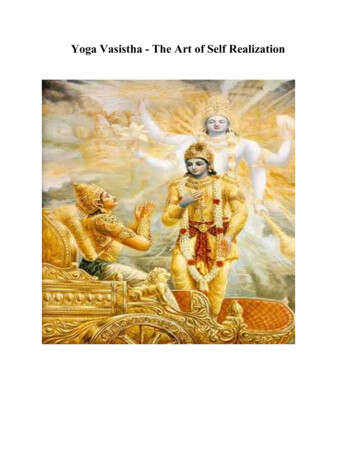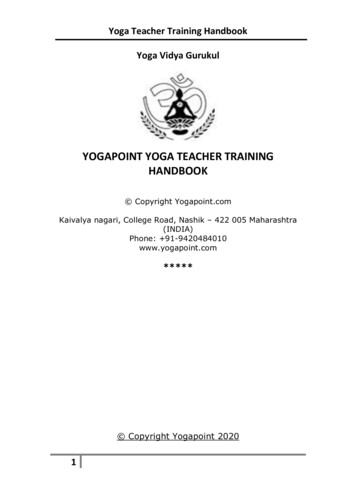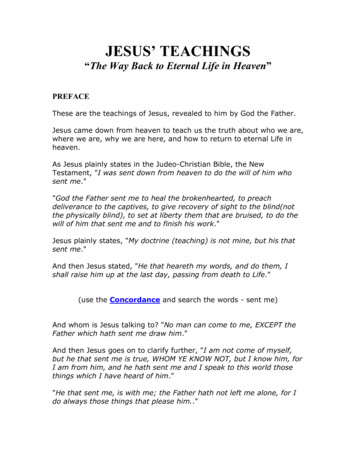
Transcription
The Yoga of Jesus:Teachings of Esoteric ChristianityMauri Lehtovirta
Mauri LehtovirtaThe Yoga of Jesus:Teachings of Esoteric ChristianityTranslated from Finnish into English byAntti SavinainenEdited byRichard Smoley2020
Mauri Lehtovirta:The Yoga of Jesus: Teachings of Esoteric ChristianityTranslated by Antti Savinainen and edited by Richard SmoleyOriginally published in Finnish: Jeesuksen jooga, 2009The book cover: Image by Venla RahkonenLayout: Jukka I. LindforsPublisher: Literary Society of the Finnish Rosy Cross, Helsinki 2020 Mauri LehtovirtaISBN 978-952-9603-58-9
Table of ContentsPreface to the English Edition . . . . . . . . . . . . . . . . . . . . . . . . . . . . . . . . . . . . . . . . 5Introduction . . . . . . . . . . . . . . . . . . . . . . . . . . . . . . . . . . . . . . . . . . . . . . . . . . . . . . . . 7Acknowledgments . . . . . . . . . . . . . . . . . . . . . . . . . . . . . . . . . . . . . . . . . . . . . . . . . . 131. God Loves a Cheerful Giver . . . . . . . . . . . . . . . . . . . . . . . . . . . . . . . . . . . . . . . 14The Gatherer . . . . . . . . . . . . . . . . . . . . . . . . . . . . . . . . . . . . . . . . . . . . . . . . . . . 14Give and You Shall Receive . . . . . . . . . . . . . . . . . . . . . . . . . . . . . . . . . . . . . . 15The Power of Giving Away . . . . . . . . . . . . . . . . . . . . . . . . . . . . . . . . . . . . . . . 17The Beauty of a Cheerful Giver . . . . . . . . . . . . . . . . . . . . . . . . . . . . . . . . . . . 22The Long Path of Growth . . . . . . . . . . . . . . . . . . . . . . . . . . . . . . . . . . . . . . . . 232. The Happiness I Give Away . . . . . . . . . . . . . . . . . . . . . . . . . . . . . . . . . . . . . . . 26The Poor in Spirit . . . . . . . . . . . . . . . . . . . . . . . . . . . . . . . . . . . . . . . . . . . . . . . 29The Mystery of Grief . . . . . . . . . . . . . . . . . . . . . . . . . . . . . . . . . . . . . . . . . . . . 33Happiness of the Peacemaker . . . . . . . . . . . . . . . . . . . . . . . . . . . . . . . . . . . . 37Righteousness and Mercy . . . . . . . . . . . . . . . . . . . . . . . . . . . . . . . . . . . . . . . . 40The Secret of Happiness . . . . . . . . . . . . . . . . . . . . . . . . . . . . . . . . . . . . . . . . . 423. The Sermon of the Mount and the Five Commandments of Freedom . . 44Avoid Anger . . . . . . . . . . . . . . . . . . . . . . . . . . . . . . . . . . . . . . . . . . . . . . . . . . . . 45Keep Your Thoughts Pure . . . . . . . . . . . . . . . . . . . . . . . . . . . . . . . . . . . . . . . 49Be Truthful in Your Speech . . . . . . . . . . . . . . . . . . . . . . . . . . . . . . . . . . . . . . 53Do Not Resist Evil . . . . . . . . . . . . . . . . . . . . . . . . . . . . . . . . . . . . . . . . . . . . . . 55Learn to Love Everyone . . . . . . . . . . . . . . . . . . . . . . . . . . . . . . . . . . . . . . . . . 594. The Lord’s Prayer and the Power of Meditation . . . . . . . . . . . . . . . . . . . . . 63The Necessity and Power of Sacralization . . . . . . . . . . . . . . . . . . . . . . . . . 63Prayer is a Spiritual Tool . . . . . . . . . . . . . . . . . . . . . . . . . . . . . . . . . . . . . 65The Sacred Universe . . . . . . . . . . . . . . . . . . . . . . . . . . . . . . . . . . . . . . . . 67The Power of Thought . . . . . . . . . . . . . . . . . . . . . . . . . . . . . . . . . . . . . . . 72Longing for the Sacred . . . . . . . . . . . . . . . . . . . . . . . . . . . . . . . . . . . . . 74The Secret of the Kingdom . . . . . . . . . . . . . . . . . . . . . . . . . . . . . . . . . . . . . . 76Enter the Kingdom . . . . . . . . . . . . . . . . . . . . . . . . . . . . . . . . . . . . . . . . . 80The Kingdom in the Parables . . . . . . . . . . . . . . . . . . . . . . . . . . . . . . . . . 82Forgiveness Opens the Door . . . . . . . . . . . . . . . . . . . . . . . . . . . . . . . . . 88The Kingdom Has Come Near . . . . . . . . . . . . . . . . . . . . . . . . . . . . . . . 913
Will Your Will Be Done? . . . . . . . . . . . . . . . . . . . . . . . . . . . . . . . . . . . . . . . . 93Will in Our Time . . . . . . . . . . . . . . . . . . . . . . . . . . . . . . . . . . . . . . . . . . 95Free Will: Where Does It Take Us? . . . . . . . . . . . . . . . . . . . . . . . . . . . . 96God Knowledge, God Feeling, and God Will . . . . . . . . . . . . . . . . . . 100God Will and the Will of God . . . . . . . . . . . . . . . . . . . . . . . . . . . . . . . 101Leap into the Unknown . . . . . . . . . . . . . . . . . . . . . . . . . . . . . . . . . . . . 102The Mystery of Supersubstantial Bread . . . . . . . . . . . . . . . . . . . . . . . . . . 104Word and Bread as Nourishment . . . . . . . . . . . . . . . . . . . . . . . . . . . . 108Sacramental Bread . . . . . . . . . . . . . . . . . . . . . . . . . . . . . . . . . . . . . . . . 109Light Is Nourishment . . . . . . . . . . . . . . . . . . . . . . . . . . . . . . . . . . . . . . 110The Most Significant Problem of Our Time . . . . . . . . . . . . . . . . . . . . . . 114Letting Go of the Emotional Hook . . . . . . . . . . . . . . . . . . . . . . . . . . . 114The Difficulty of Forgiveness . . . . . . . . . . . . . . . . . . . . . . . . . . . . . . . . 116The Great Example . . . . . . . . . . . . . . . . . . . . . . . . . . . . . . . . . . . . . . . . 117Who is Burdened by the Debt? . . . . . . . . . . . . . . . . . . . . . . . . . . . . . . 119In Debt to Life . . . . . . . . . . . . . . . . . . . . . . . . . . . . . . . . . . . . . . . . . . . . 120Is Justice Delivered? . . . . . . . . . . . . . . . . . . . . . . . . . . . . . . . . . . . . . . . 123Practice Makes Perfect . . . . . . . . . . . . . . . . . . . . . . . . . . . . . . . . . . . . . 124In the School of Good and Evil . . . . . . . . . . . . . . . . . . . . . . . . . . . . . . . . . 128The School of Temptations . . . . . . . . . . . . . . . . . . . . . . . . . . . . . . . . . 129Deliver Us from Evil . . . . . . . . . . . . . . . . . . . . . . . . . . . . . . . . . . . . . . . 132Crushing and Uplifting the Power of Guilt . . . . . . . . . . . . . . . . . . . . 140Is Guilt Inheritable? . . . . . . . . . . . . . . . . . . . . . . . . . . . . . . . . . . . . . . . 143How Do We React to Our Guilt? . . . . . . . . . . . . . . . . . . . . . . . . . . . . 144Guilt Is a Message . . . . . . . . . . . . . . . . . . . . . . . . . . . . . . . . . . . . . . . . . 147From Guilt to Love . . . . . . . . . . . . . . . . . . . . . . . . . . . . . . . . . . . . . . . . 1485. The Inexhaustible Wisdom of the Sermon on the Mount . . . . . . . . . . 153The Resounding Gong and Music of the Spheres . . . . . . . . . . . . . . . . . 153The Salt of the Earth and the Light of the World . . . . . . . . . . . . . . . . . 158Everything Flows . . . . . . . . . . . . . . . . . . . . . . . . . . . . . . . . . . . . . . . . . . . . . 162Life Supports You . . . . . . . . . . . . . . . . . . . . . . . . . . . . . . . . . . . . . . . . . . . . . 164Bibliography . . . . . . . . . . . . . . . . . . . . . . . . . . . . . . . . . . . . . . . . . . . . . . . . . . . . . . 170Further Readings by Pekka Ervast in English . . . . . . . . . . . . . . . . . . . . . . . 1724
Preface to the English EditionThe Yoga of Jesus was published in Finnish in spring 2009. The textand title were already finished in January 2009 when I heard thatthere is a book compiled from Paramahansa Yogananda’s writingshaving the same name in English. I didn’t know at the time that wewould translate the book into English for interested readers in theUnited States and elsewhere. The present work and Yogananada’sbook have only in common that they both comment on the beatitudes in the Sermon on the Mount. It is interesting to note howclose the interpretations coming from different traditions can be,as well as how sacred books can be opened with various keys, so tospeak. It is also important to remember what Pekka Ervast (1875–1934), a Finnish Theosophist and expert on esoteric Christianity,advised: readers should delve into the spirit of the Sermon on theMount and find the interpretation that is closest to them. Ervasthas been, and still is, an important spiritual teacher in Finland. Hewas an author who had deep insights into the meaning of Jesus’ssayings. With great heart and wisdom, Ervast familiarized himselfwith the spiritual practices contained in the Sermon on the Mount;he probably was the first one in the world to talk about the changesthat take place in those who follow Jesus’s five commandments intheir lives.For the last thirty-five years, I have lived as an active truth seeker. I started to understand the deeper aspects of Christianity afterI had a strong transformative experience thirty years ago. I havedelivered lectures and written a great deal about it, and many timesI’ve been asked whether I am planning to write another book. Ihave answered that I have no such plans: the system of spiritual development described in this book is enough for the rest of my life.5
Following the path taught by Jesus in the Sermon on the Mount isso demanding in practice that I’m quite certain that my lifetimeis not enough to reach the goal. Seeking for truth, talking aboutspiritual matters, lecturing, and artistic performances in the formof music and songs have been important ways to make spiritualknowledge and insights available to others. However, truth willbegin to reveal itself only after we start applying it in everyday life,among people, as we make esoteric Christianity a touchstone ofour lives.I wish to express my heartfelt gratitude to Antti Savinainenand Richard Smoley for their diligent efforts to translate and editThe Yoga of Jesus, which has no doubt been a demanding process.Moreover, I wish to thank the Kulmakoulu Foundation, which hasprovided financial support for this project. It is my deepest hopethat the teachings of The Yoga of Jesus will provide the reader’s heartand mind with strength, joy, and light. I believe, and I know personally, that these teachings have the power to do so.Mauri LehtovirtaHelsinkiFebruary 19, 20206
IntroductionI have titled this book The Yoga of Jesus. The title might give rise towondering, even objections. Hence some justification is in order.Was Jesus familiar with the yoga tradition in the East? Did he studyit at some point in his life? Isn’t it daring to claim that he wouldhave practiced yoga or that he would have had taught some kind ofspiritual system?Even today there are sources indicating that Jesus might havebeen in contact with spiritual schools and teachers outside of Palestine and Judea, that is, in Egypt, Persia, even India, during his “lostyears,” about which the Bible remains silent.*It is highly likely that Jesus studied the ancient tradition of yogaand its philosophy during his earthly life. Furthermore, it is clearthat he built his own teachings about the spiritual path on the ethics and spiritual knowledge that were available in the Middle East,Egypt, Persia, and India. This was the very foundation on whichthe yoga philosophy and ethics of that time were based. Yoga, anancient tradition combining physical practices with spiritual aspirations, evolved in India thousands of years before Jesus was born.As a word, it means union or connection. The word is etymologically related to the Latin verb jungere, which means to join.At present most of the yoga traditions adopted here in the Westoffer posture (asana) and breathing exercises. They chiefly aim at*Swami Abhedananda, Journey to Kashmir and Tibet (Calcutta: RamakrishnaVedanta Math, 1987); Pekka Ervast, The Foundational Questions in Christosophia [title translated from the Finnish; not available in English] (Imatra:Finnish Rosy Cross, 1940); Nicolas Notovitch, The Unknown Life of Jesus(Self-published, 1894); Gopala Das Venu, The Secret Life of Jesus [title translated from the Finnish; not available in English], (Järvenpää, Finland: Selfpublished, 2006); Paramahansa Yogananda, The Second Coming of Christ (LosAngeles: Self-Realization Fellowship, 2004).7
physical flexibility as well as calming and silencing the mind. Theultimate purpose of yoga is complete control of body and mind,and, through this, union with the highest consciousness, samadhi,and finally, escape from the wheel of reincarnation.What is the meaning of the yoga of Jesus as I refer to it in thisbook? I mean the maxims of life Jesus gave us—his ethical teachings. Jesus provides us with these in his speeches and parables aswell as in the exemplary actions of his life. The core of his teachingsis summarized in the Sermon of the Mount in the Gospel of Matthew; it is codified in the beatitudes, the five commandments, theLord’s Prayer, and other supplementary guidelines for life, all ofwhich are given here.Up to now the notion of the yoga of Jesus has been used principally by the Theosophical movement, which has investigated thecommon origin and similarities of various religions and spiritualsystems for over a hundred years. I have long been inspired by theidea of Jesus’s ministry as a yoga, which could open a new perspective on the spiritual dialogue between the East and the West(which, we are told, never meet). The idea of Jesus’s teaching as ayoga can create many methods of integration. It can inspire comparisons between different spiritual traditions, recognizing theirsimilarities and common objectives.On the one hand, it is possible to consider the Sermon on theMount as a mere speech; after all, it is a sermon delivered by Jesus.*What kind of yoga could that be? On the other hand, isn’t a sermonmeant to be studied, practiced, and followed in life? If one goes intothe words and beyond them, one can certainly see similarities andcommon objectives between the core of yoga and the teachings ofJesus. The latter clearly correlate with the yogic notions of yamaand niyama, which form the basis of the code of ethics in yoga.In turn, if we take a look at the Lord’s Prayer, we notice that it is ameditative and mantralike practice of yoga. When it is taken fromthe realm of ideas into everyday life, it can become the yoga of*Editors’ note. Contemporary New Testament scholarship generally holds thatthis was never a sermon actually delivered by Jesus at a specific time, butrather a compilation of his sayings made by the evangelist.8
action: karma yoga. In this way it is possible to work on practicingforgiveness.Pekka Ervast stated over hundred years ago: “Meditation isbased on knowledge that a human being has been endowed witha spiritual tool allowing him to rule the worlds; this tool makes itpossible to place oneself in the correct state. This peculiar occulttool is thought, and its proper use is meditation or prayer.” * In thephilosophy of yoga, meditation is quieting the mind. One is placedin the “correct state” in the Lord’s Prayer; it is in the state in whichthe mind can be quieted.Usually spiritual traditions do not distinguish between thoughtsand actions, but when spiritual aspiration is put into practice, oneis sooner or later bound to face the fact that a thought is also anact. In the yoga of Jesus, the traditional yogic asanas can be equatedwith spiritual asanas, that is, attitudes. In Finnish, even the terms(asana in Sanskrit and asento in Finnish) are almost the same. Thecore aim in both traditions is the control of the mind. Union isanother common aim: both ways of yoga look for contact with thehigher consciousness, the higher self, or God, depending on one’sconceptual framework. Jesus uses the expression the kingdom ofheaven or the kingdom of God. He has a saying referring to whatwas stated above: “The kingdom of God is within you” (Luke 17:21,King James Version). The yoga of Jesus, like other kinds, opens upthe contact with the divine that is hidden in every human being.The ideas of reincarnation and karma are deeply embedded intraditional yoga philosophy. To put it briefly, human beings areborn in this school of life, the school of good and evil, again andagain in order to learn and gradually become perfect. Individualscan exercise their free will and choose whether they develop quickly or slowly toward their grand aim. The law of karma is like a lawof nature: it is based on a chain of inevitable cause and effect. Auniversal law of justice and love, it ensures that all human beingsmust answer for their actions sooner or later. A good act will befollowed by a good effect. The same holds true with evil acts, which*Pekka Ervast, St. Paul and His Christendom (1923). Not available in English.9
will be followed by lessons taught by suffering, either in this incarnation or in one to come. We reap what we sow.The ideas of reincarnation and karma have become familiar toever increasing groups of spiritual seekers in many countries overthe past decades. There have been voices among the priests in ourLutheran church (the dominant church in Finland) suggestingthat everyone will go to heaven after death. Actually, this idea hasalways been valid, as it is clear that Jesus knew about the law ofreincarnation. There are also some references to reincarnation inJesus’s sayings in the Bible, although they were downplayed if notsuppressed in later centuries.I wish to examine the teachings of Jesus, his yoga, in the contextof reincarnation and karma. The crucial point is how Jesus teachesus to live. The Lutheran church has always stressed Jesus’s redemptive death, atonement for sins, and his role as a savior rather thanhis teachings. In addition, it has regarded salvific faith as the keyto eternal life in heaven. From the perspective of karma and reincarnation, this kind of salvation is not the final destination, sinceit is very rare that a person would become perfect within one lifetime. Hence it is not reasonable to think that God would condemnpeople to eternal damnation for failing to place their faith in JesusChrist. Moreover, it is very hard to believe in a God who wouldinflict upon people he created the extremely cruel punishment ofeternal hell.Jesus showed an exemplary model of the human being in his lifeand teachings, which continuously emphasize people’s responsibility for their own lives. He reminds us, “Not everyone who says tome, ‘Lord, Lord,’ will enter the kingdom of heaven, but only the onewho does the will of my Father who is in heaven” (Matthew 7:21).Clearly Jesus is not talking about heaven in the afterlife. Instead,he is talking about the ethical path of the New Covenant, whichleads the follower into Christ consciousness, the inner knowing ofChrist. That is the kingdom of heaven to which Jesus so often refers in his teachings and parables and which has come closer to usthrough his life and work. It is the invisible kingdom, which is hidden in our hearts. This perspective is worth gaining in the twenty10
first century. Indeed all of Jesus’s followers, Christians and thosewho are interested in what he really said, would do well to directall their will and faith toward the hidden kingdom in our hearts.Growing as a human being is intimately tied into taking responsibility for one’s life. The aim of the yoga of Jesus does not lie inpersonal salvation; instead it is in learning to grow in wisdom andbrotherly love, whereby we all serve each other. The question ofthe New Covenant is how we can strive ethically to bring about thekingdom of heaven here on earth. This would make our development toward true humanity through reincarnation less difficult.The yoga of Jesus provides us with keys and directions for spiritual aspiration, in which no effort goes to waste. The incentives ofthis yoga include a new kind of vision, growing spiritual strength,the opportunity for an ever growing consciousness, and enlightenment. Jesus was the first example—the first of our brothers to finishthis school and show us the perfection a human being can attain inthis earthly school.Jesus’s guidelines, his five commandments in the Sermon on theMount, are not familiar to many, since the Christian church has notgiven much emphasis to their Master’s maxims. For some reason,it prefers to teach the Law of Moses—the Ten Commandments—even though Jesus says he has not come to abolish the Law but tofulfill it. Jesus’s instructions are different from the old commandments: they are more intimate. Jesus’s maxims are not based on theLaw: following them is voluntary. If you try to follow them, therewill be certain results.Jesus complemented his commandments with the beatitudesand the Lord’s Prayer as well as with other ethical instructionsfound in the Sermon on the Mount. They are organically connected, and they complement each other. It makes no sense to codifythem into a single canonical system of dogmas. The interpretationsof these maxims only become valid if we personally think, feel, will,and live up to them in our everyday lives. This is not easy, but it isessential to start trying, to take the path. They are challenging andrewarding for those who practice them, as true spiritual exercisesalways are. Jesus himself promises that all who ask shall receive,11
the seeker will find, and the door will be opened for the one whoknocks.The five chapters in The Yoga of Jesus are essays, treatises, and reflections in which I consider the meaning of the core teachings ofthe Sermon on the Mount for myself and all of us with the help ofspiritual teachers who are important to me.* The chapters are morelike openings for individual reflection and understanding by thereader rather than instructional advice as such.The first chapter, “God Loves a Cheerful Giver,” which can beregarded as a follow-up to the introduction, discusses the logic ofthe teachings of Jesus, in which he considers the basic needs of ourlife and being. That logic accompanied Jesus throughout his wholelife and teachings. It was surprisingly radical and revolutionary inhis own time, and still is.I have entitled the second chapter “The Happiness I Give Away.”It addresses the beatitudes at the beginning of the Sermon on theMount, in which Jesus defines the keys to enduring happiness. Dowe understand these proclamations? Are we able to interpret them?The third chapter, entitled “The Sermon of the Mount and theFive Commandments of Freedom,” deals with the “new” maximsin five sections, each of which opens up new spiritual abilities ortranscendental senses for their practitioner.The fourth chapter is called “The Lord’s Prayer and the Power ofMeditation.” It is divided into six long sections, which concentrate,sentence by sentence, on the prayer meditation given to us by Jesus.The fifth chapter, “The Inexhaustible Wisdom of the Sermon onthe Mount,” assembles some central definitions and instructionsgiven by Jesus in addition to the beatitudes, the five commandments, and the Lord’s Prayer.*Editors’ note. The cited passages from the Sermon on the Mount (Matthew5–7) are for the most part not referenced in the text in order to enhance theflow of the book. However, references for all other Bible verses have beenprovided. All biblical quotations have been taken from the New InternationalVersion (NIV) unless otherwise noted.12
AcknowledgmentsI do not wish to provide a detailed list of those who should bethanked. Everyone who has helped to publish this book and workedfor its dissemination deserves great thanks. I almost dare to say thatour Father in heaven, who sees all, will reward him or her.Mauri LehtovirtaHelsinkiOctober 18, 200713
1God Loves a Cheerful GiverEach generation is baffled by Jesus’s actions and teachings, whichdo not follow common customs or conventions. It is possible tonotice echoes from the martial arts in his thinking: the opponent’sstrength is shifted or shown to be a weakness, and traditional waysof reacting are replaced with new and surprising ones. Similarly,followers of the yoga of Jesus must rethink the basis for their actions and strategies.Our everyday language has an abundance of old sayings andaphorisms. We cannot always be sure of their origins, and we seldom pause to think about their deeper meaning. “God loves acheerful giver” is a saying I heard when I was a young boy. We usedto playfully say that it was a motto for prostitutes. Many decadeslater, I decided to search for the origin of this idea. I recognizedthat it comes from the Bible (2 Corinthians 9:7). If one realizesthis, one soon observes that it contains truths that are as big as lifeitself. A cheerful giver is a highly developed person who has theright relationship to his or her fellow human beings, life, and thewhole of reality.The GathererWhen we look back at history, we notice that human beings andcommunities lived for thousands of years in gathering economies.People gather, first, food and other necessities of life, and then, little by little, land and property, things and goods. This way, theyprovide for their own safety. They plan and build complex systemsto make sure that nobody can steal their goods, property, or land.14
The gatherer economy appears to be alive and well today: westill use its approach to create safety for ourselves. What has beengained must somehow be protected. Each human being, family,tribe, and state has its own systems of attack, defense, and security. We build our own safety, and that of those who are close to us,around the goods and property that we have amassed. The greaterthe accumulated property, the more security, defense, and insurance policies we must assemble to protect it.The most important question in a life that is built on securityof goods appears to be, “What else could I get for myself?” Thisquestion also seems to define our relationship to nature, other human beings, and God—and to life itself. Both for communities andindividuals, safety based on ownership has long been establishedby law. Deeply ingrained statutes and norms support and protectthis process of accumulation, both individually and communally.By contrast, spiritual awakenings, great prophets, and the founders of religions have always tried to show that this attitude of accumulation is unsustainable. After the prophet has gone away, however, his voice is weakened, and his powerful teaching starts to dimand become institutionalized. Gradually the mentality of materialsecurity starts to flourish again, and the “I want it, and I want itnow” philosophy reigns.Jesus of Nazareth, a prophet born in Judea two thousand yearsago, attempted to demolish the way of life based on the security ofgoods. His whole life’s work was consistently directed against itsphilosophy, and his teachings call us to abandon its customs andhabits.Give and You Shall ReceiveSo far, Jesus Christ has been the purest manifestation of God’seternal image of the ideal human being. In Theosophy, this idealimage is called the Cosmic or Mystic Christ. Jesus Christ was amaster who was perfectly able to exemplify in his teachings andlife the central feature of the Cosmic Christ, that is, love. The logicof Jesus’s teaching and action is that of love. When one remembers15
that the most accurate characterization of love is based on giving,one understands why Jesus so vehemently opposed the prevailing“What could I have for myself?” type of thinking.The principles of cheerful giving and relinquishing—which donot come by coercion—are constantly present throughout Jesus’steaching. His life as a whole is a great lesson of love. When we examine the texts that tell us about Jesus, we notice that he constantlyreverses the demands and expectations of having into giving. InJesus’s language, giving means letting go, abandoning the old wayof life, forgiving, relinquishing, and many similar things. Whenlove is extended to the utmost, we come to the ultimate sacrifice:giving one’s own life.I may wonder what Jesus’s statement to the rich man means tome: “If you want to be perfect, go, sell your possessions and give tothe poor, and you will have treasure in heaven. Then come, followme” (Matthew 19:21). In short, “Let go of all your belongings. Letgo of your old life, which leads nowhere, and follow me. I am thetruth and the life. You cannot serve two masters, God and mammon.” Jesus’s urging is unconditional: either or! Moths will eat belongings, but not even the devil can touch the spirit. Is this just astory told in the Bible, or does it speak to me in any way?I suppose that many, like me, will remember the following statement from their childhood: “It is easier for a camel to go throughthe eye of a needle than for someone who is rich to enter the kingdom of God” (Mark 10:25). I remember thinking, “It’s so hard forrich people!” But where do we draw the line between the rich andthe poor? Jesus means that everyone is rich who is attached to hisor her possessions, no matter how much or how little money onehas. Giving up money and property, that is mammon, is a call for avoluntary poverty. It is the poetry of a simple life. At the same time,it calls for a serious and demanding resolve.Probably the one who was most successful in this endeavor wasFrancis of Assisi, God’s poor holy man. It is interesting to note thatthe Roman Catholic church, with its abundant luxury and wealth,elevated him as a saint. Holy simplicity is a term often associatedwith Francis, but it does not mean simplicity in thought; instead16
it means the spiritual state which grows out of renouncing andcheerful giving. A better translation would be “holy poverty.” Today Francis is seeing a new renaissance as ecophilosophers and theecological movement have taken him as their patron saint.Compulsive hanging on to property starts to weaken when aperson starts to seek for truth in life and understands the meaningof brotherhood. He realizes that the natural order of things meansthat if I have too much, someone else has too little. Brotherhoodamong people is an occult fact, although it can be seen everywhere.It can reveal itself to a truth seeker in the first words of the Lord’sPrayer. Jesus recommends that we pray as follows: “Our Father,who art in heaven.” W
The Yoga of Jesus, which has no doubt been a demanding process. Moreover, I wish to thank the Kulmakoulu Foundation, which has provided financial support for this project. It is my deepest hope that the teachings of The Yoga of Jesus will provide the reader’s heart and mind










